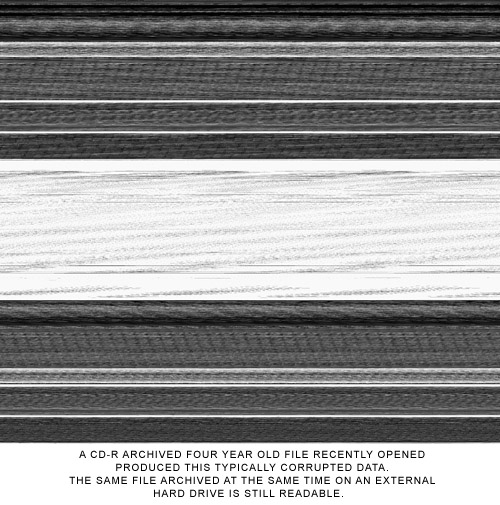Shoebox mentality.
However, come the day I am no longer around to point people who might want to see any of this stuff in the right direction, they will (hopefully) not find access to the material too difficult. It's labeled and stored in a sort of orderly fashion. At least, this is the scenario for 90% of the analogue material, the negatives, prints and transparencies.
The same is not true of the digital analogue archives or of the more recently acquired digitally captured material. This is stored on a variety of recordable media, including metal oxide and optical.
Assuming all the hardware necessary to access these files is frequently upgraded and the files themselves are frequently transferred to new recording media, anyone so inclined will be able to access the images.
A lot of time, far too much in fact, is already devoted to duplicating master CDs, Zip and MO discs and backing up hard drives, but I see nothing looming on the horizon of this year's photokina in the way of hardware or media which is going to make this task less demanding or less frustrating. What happened to Hitachi's 3d recording technology? What happened to Maxell's impending launch a year ago of their new holographic based technology? What happened to the self propogating crystal flourite technology I wrote about almost four years ago that would save archivists from an early death?
Just recently, in need of an image to illustrate an article, the only digital version of it archived I could find, was on a 6 year old Zip disk. The file stubbornly refused to open on three different Macs, and not even the synthesized friendly voice of a 1993 Mac Performa could subdue my rage.

In the past, I have written at length of the tests I have made on proprietary CD-R media. In one article, I suggested cheap discs be avoided for the storage of valuable files; instead, pay a little more for gold layer types. Well, I paid a lot more for gold layer types manufactured in Germany. The data on these has been checked once a year for four years. Last time I looked a month ago, several files refused to open or opened with file faults, image data missing from half the image is usual. I purchased cartloads of Kodak's gold+silver discs just as the product was being discontinued. Recorded discs are diligently inspected and now, four years along, some files have problems.
The only media discs which seems to maintain some integrity, are MO disks, but these are relatively expensive, so I have moved more in the direction of high capacity stand alone hard drives. I don't buy anything I cannot find detailed technical specs for and until it changes, the quoted industry standard for a hard drive life of 20,000 hours or approximately 2.28 years is uppermost in my mind when I enter a pin number to pay for it.

2.28 years?
Are they kidding?
I have Agfa Kraft boxes full of bromide prints that are 40 years old as good as the day they were made. There are glass plates in the collection dating back to 1858 on which the silver image is alive and well. Even early Autochromes and some Dufaycolour transparencies more than 70 years old are in fine shape.
It's all very well for manufacturers to continually up the specs and features of digital capture cameras, but if they cannot get their heads around what I think is their moral obligation to also put in place some way of permanently archiving the images I shoot with their gear, I may stop using it.
Oddly, when I asked Leica about this a few years ago - before they had been well shaken by Epson's RD1 debut, it was suggested that if I really needed a higher level of archive security for my digital files, there really was only one medium that could provide it; yep, you guessed. Film they said. It's the only way.
I have the feeling that if I asked the same question today, the same answer would be on the cards, in spite of the advances made for RAW capture software.
Out of the thousands of digitally captured images I add to the picture library each year, I might, after some careful editing, initially decide it is only worth recording a small percentage of these. The additional costs of film and processing would be minimal, but for the moment there is no reasonably priced digital to film recording hardware available.
-------------
Visitors, users and
viewers of the foregoing content may copy and re-use it
in other internet content sites on condition the source
of all material so used is acknowledged with the
attachment of the following.
Copyright; Jonathan Eastland 2006.
www.ajaxnetphoto.blogspot.com
www.ajaxnetphoto.com
This content may NOT be used in any print media made
available for commercial resale.
The products and companies named in this website content
are trademarks , registered trademarks or servicemarks
of their respective owners or licensed users.